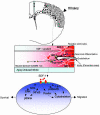Directed migration of neural stem cells to sites of CNS injury by the stromal cell-derived factor 1alpha/CXC chemokine receptor 4 pathway
- PMID: 15608062
- PMCID: PMC536055
- DOI: 10.1073/pnas.0408258102
Directed migration of neural stem cells to sites of CNS injury by the stromal cell-derived factor 1alpha/CXC chemokine receptor 4 pathway
Abstract
Migration toward pathology is the first critical step in stem cell engagement during regeneration. Neural stem cells (NSCs) migrate through the parenchyma along nonstereotypical routes in a precise directed manner across great distances to injury sites in the CNS, where they might engage niches harboring local transiently expressed reparative signals. The molecular mechanisms for NSC mobilization have not been identified. Because NSCs seem to home similarly to pathologic sites derived from disparate etiologies, we hypothesized that the inflammatory response itself, a characteristic common to all, guides the behavior of potentially reparative cells. As proof of concept, we show that human NSCs migrate in vivo (including from the contralateral hemisphere) toward an infarcted area (a representative CNS injury), where local astrocytes and endothelium up-regulate the inflammatory chemoattractant stromal cell-derived factor 1alpha (SDF-1alpha). NSCs express CXC chemokine receptor 4 (CXCR4), the cognate receptor for SDF-1alpha. Exposure of SDF-1alpha to quiescent NSCs enhances proliferation, promotes chain migration and transmigration, and activates intracellular molecular pathways mediating engagement. CXCR4 blockade abrogates their pathology-directed chain migration, a developmentally relevant mode of tangential migration that, if recapitulated, could explain homing along nonstereotypical paths. Our data implicate SDF-1alpha/CXCR4, representative of the inflammatory milieu characterizing many pathologies, as a pathway that activates NSC molecular programs during injury and suggest that inflammation may be viewed not simply as playing an adverse role but also as providing stimuli that recruit cells with a regenerative homeostasis-promoting capacity. CXCR4 expression within germinal zones suggests that NSC homing after injury and migration during development may invoke similar mechanisms.
Figures





Similar articles
-
CXC Chemokine Receptor 4 Is Expressed Paravascularly in Apical Papilla and Coordinates with Stromal Cell-derived Factor-1α during Transmigration of Stem Cells from Apical Papilla.J Endod. 2015 Sep;41(9):1430-6. doi: 10.1016/j.joen.2015.04.006. Epub 2015 May 21. J Endod. 2015. PMID: 26003008
-
Hypoxia enhances CXCR4 expression favoring microglia migration via HIF-1alpha activation.Biochem Biophys Res Commun. 2008 Jun 27;371(2):283-8. doi: 10.1016/j.bbrc.2008.04.055. Epub 2008 Apr 22. Biochem Biophys Res Commun. 2008. PMID: 18435916
-
Physical exercise regulates neural stem cells proliferation and migration via SDF-1α/CXCR4 pathway in rats after ischemic stroke.Neurosci Lett. 2014 Aug 22;578:203-8. doi: 10.1016/j.neulet.2014.06.059. Epub 2014 Jul 7. Neurosci Lett. 2014. PMID: 25010020
-
Genetically manipulated progenitor/stem cells restore function to the infarcted heart via the SDF-1α/CXCR4 signaling pathway.Prog Mol Biol Transl Sci. 2012;111:265-84. doi: 10.1016/B978-0-12-398459-3.00012-5. Prog Mol Biol Transl Sci. 2012. PMID: 22917235 Review.
-
Trafficking of normal stem cells and metastasis of cancer stem cells involve similar mechanisms: pivotal role of the SDF-1-CXCR4 axis.Stem Cells. 2005 Aug;23(7):879-94. doi: 10.1634/stemcells.2004-0342. Epub 2005 May 11. Stem Cells. 2005. PMID: 15888687 Review.
Cited by
-
Human iPSC-derived neural stem cells displaying radial glia signature exhibit long-term safety in mice.Nat Commun. 2024 Nov 1;15(1):9433. doi: 10.1038/s41467-024-53613-7. Nat Commun. 2024. PMID: 39487141 Free PMC article.
-
Nanoparticles and Mesenchymal Stem Cell (MSC) Therapy for Cancer Treatment: Focus on Nanocarriers and a si-RNA CXCR4 Chemokine Blocker as Strategies for Tumor Eradication In Vitro and In Vivo.Micromachines (Basel). 2023 Nov 7;14(11):2068. doi: 10.3390/mi14112068. Micromachines (Basel). 2023. PMID: 38004925 Free PMC article. Review.
-
Neurogenesis in Alzheimer´s disease: a realistic alternative to neuronal degeneration?Curr Signal Transduct Ther. 2011 Sep 1;6(3):314-319. doi: 10.2174/157436211797483949. Curr Signal Transduct Ther. 2011. PMID: 22125505 Free PMC article.
-
Accelerated and enhanced effect of CCR5-transduced bone marrow neural stem cells on autoimmune encephalomyelitis.Acta Neuropathol. 2012 Oct;124(4):491-503. doi: 10.1007/s00401-012-0989-1. Epub 2012 Apr 22. Acta Neuropathol. 2012. PMID: 22526024 Free PMC article.
-
Fate of transplanted bone marrow derived mesenchymal stem cells following spinal cord injury in rats by transplantation routes.J Korean Med Sci. 2012 Jun;27(6):586-93. doi: 10.3346/jkms.2012.27.6.586. Epub 2012 May 26. J Korean Med Sci. 2012. PMID: 22690088 Free PMC article.
References
-
- Imitola, J., Snyder, E. Y. & Khoury, S. J. (2003) Physiol. Genomics 14, 171–197. - PubMed
-
- Park, K. I., Ourednik, J., Ourednik, V., Taylor, R. M., Aboody, K. S., Auguste, K. I., Lachyankar, M. B., Redmond, D. E. & Snyder, E. Y. (2002) Gene Ther. 9, 613–624. - PubMed
-
- Park, K. I., Teng, Y. D. & Snyder, E. Y. (2002) Nat. Biotechnol. 20, 1111–1117. - PubMed
Publication types
MeSH terms
Substances
LinkOut - more resources
Full Text Sources
Other Literature Sources
Medical
Molecular Biology Databases
Research Materials

